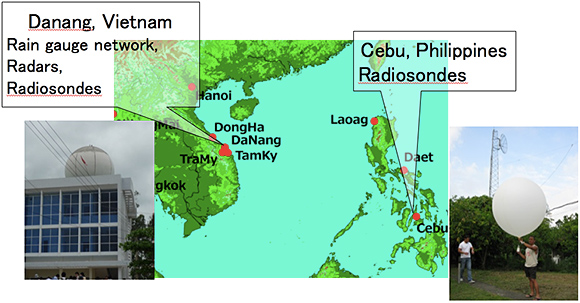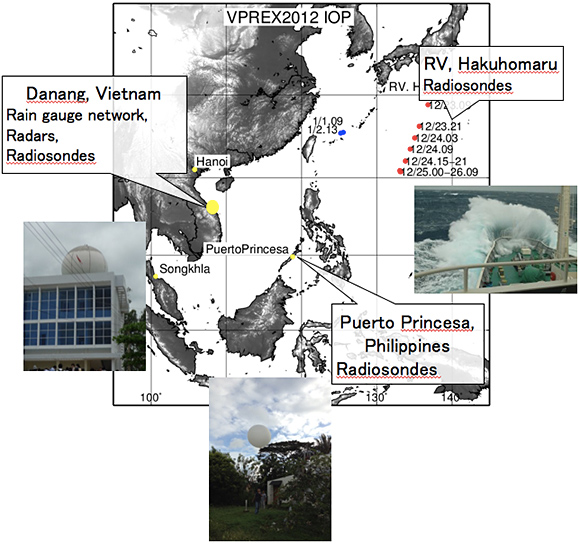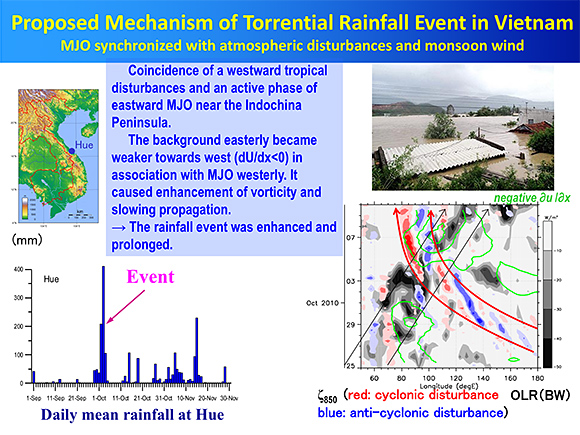VPREX: Vietnam Philippines Rainfall Experiment
Background
Along the east coasts of Vietnam and Philippines, precipitation in autumn and winter is the major source of annual precipitation. Especially over central Vietnam, more than 70% of annual precipitation occurs from September to December. The rainfall event in this season tends to provide significant amount of precipitation in a short time. However, the generation and maintenance mechanism of heavy rainfall is not fully understood.
Objectives
The purpose of the experiment is to understand the generation and maintenance mechanism of the heavy rainfall in central Vietnam and in the Philippines. Obtained results would be utilized to predict the heavy rainfall to prevent flood disasters there.
Participants / Main conducting organizations
- The Philippine Atmospheric Geophysical and Astronomical Services Administration (PAGASA)
- Vietnamese National Hydrometeorological Service (VNHMS)
- Thai Meteorological Department (TMD)
- Japan Agency for Marine-Earth Science and Technology (JAMSTEC)
Participating organizations
- Institute of Meteorology, Hydrology and Environment (IMHEN), Vietnam
- Hanoi University of Science (HUS), Vietnam
- Tokyo Metropolitan University, Japan
- Kobe University, Japan
Observation campaigns
Detailed horizontal structures of rainfall events was observed by the dense rain-gauge network distributed at 30 stations and the automatic weather stations at the 3 stations around Da Nang City in central Vietnam, and by the routine radars, hydrological and meteorological instruments of Vietnam National Hydro-Meteorological Service.
In order to capture the westward-propagating tropical disturbances and the winter monsoon surges and to clarify the vertical structure of the convections, the intensive radiosonde observations were conducted in Vietnam, Philippines and Thailand.
The semi-real-time forecast experiment using the Non-Hydrostatic Model (NHM) of Japan Meteorological Agency was executed in parallel with the observations.
During the 2012 experiment, the intensive radiosonde observation was conducted on board the research vessel “Hakuho-maru” over the Phillipines sea to measure the air-sea interaction that may affect the precipitation along the eastern coast of Phillipines.
The details of the campaigns are as follows:
VPREX 2010 (September 2010-January 2011)
Vietnam
- Four-times daily intensive radiosonde observations at Danang, Central Vietnam from October 1 to November 30.
- Rain-gauge network observation at 30 stations in central Vietnam.
- Radar observations at Tam Ky and Dong Ha and routine surface meteorological observations in central Vietnam by NHMS.
Philippines
- Twice-daily intensive radiosonde observations at Mactan, Cebu from September 15, 2010 to January 19, 2011.

VPREX 2012 (September 2012-December 2012)
Vietnam
- Four-times daily intensive radiosonde observations at Danang, Central Vietnam from October 1 to November 30, 2012.
- Four-times daily intensive radiosonde observations at Danang and Hochiminh from December 27, 2012 to January 5, 2013. ?
- Rain-gauge network observation at 30 stations in central Vietnam.
- Radar observations at Tam Ky and Dong Ha and routine surface meteorological observations in central Vietnam by NHMS.
Philippines
- Intensive radiosonde observations at Puerto Princesa, Palawan, Philippines from December 15 to 22.
Thailand
- Four-times daily intensive radiosonde observations at Songkhla from December 24, 2012 to January 2, 2013.
Hakuho-maru
- Intensive radiosonde observation on board the research vessel “Hakuho-maru”. Twice or four-times daily observation was conducted during the cuise from 29N to 21N latitudes and from December 23 to 24, 2012, and eight-times daily observation at the fix-point (21N, 133E) from December 24 to 25, 2012.

Data
The VPREX observation data have been open to the world scientific research community. The basic data policy will follow the AMY Data Guideline. The data can be obtained from the JAMSTEC website:
The VPREX observation data have been open to the world scientific research community. The basic data policy will follow the AMY Data Guideline. The data can be obtained from the JAMSTEC website:
- JAMSTEC Tropical Atmospheric Observation Dataset (Danang) - Data Catalog
- JAMSTEC Tropical Atmospheric Observation Dataset (Mactan) - Data Catalog ,
and also through the Data Integration & Analysis System (DIAS):
Quick Look Results
Preliminary analysis of the daily rainfall amount at Da Nang and Hovmoeller diagram of 850 hPa relative vorticity during VPREX2010 show that the rainfall activity at Da Nang was intensified when the tropical disturbances arrived at the east coast of Vietnam.

Publications
- Wu, P., Y. Fukutomi, and J. Matsumoto (2012), The Impact of Intraseasonal Oscillations in the Tropical Atmosphere on the Formation of Extreme Central Vietnam Precipitation, SOLA, 8, 57-60, doi:10.2151/sola.2012-015.
- Hattori, M., J. Matsumoto, S.-Y. Ogino, T. Enomoto, and T. Miyoshi (2016), The Impact of Additional Radiosonde Observations on the Analysis of Disturbances in the South China Sea during VPREX2010, Sola, 12, 75-79, doi:10.2151/sola.2016-018.
- Ogino, S.-Y., M. D. Yamanaka, S. Mori, and J. Matsumoto (2016), How Much is the Precipitation Amount over the Tropical Coastal Region?, J. Clim., 29(3), 1231-1236, doi:10.1175/JCLI-D-15-0484.1.
- Hattori, M., A. Yamazaki, S.-Y. Ogino, J. Matsumoto (2017), The Impact of the Radiosonde Observations of Cold Surge over the Philippine Sea on the Tropical Region and the Southern Hemisphere in December 2012, SOLA, 13, 19–24, doi:10.2151/sola.2017-004.
- Ogino, S.-Y., M. D. Yamanaka, S. Mori, and J. Matsumoto (2017), Tropical coastal dehydrator in global atmospheric water circulation. Geophys. Res. Lett., 44, 11,636–11,643, https://doi.org/10.1002/2017GL075760. (Selected as Research Spotlight of American Geophysical Union: Rethinking How Water Circulates Between the Oceans and Land
https://eos.org/research-spotlights/rethinking-how-water-circulates-between-the-oceans-and-land) - Ogino, S.-Y., P. Wu, M. Hattori, N. Endo, H. Kubota, T. Inoue and J. Matsumoto (2018), Cold surge event observed by radiosonde observation from the research vessel ``Hakuho-maru'' over the Philippine Sea in December 2012, Prog. Earth Planet Sci., 5:9, doi:10.1186/s40645-017-0163-4.